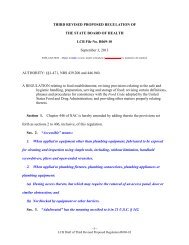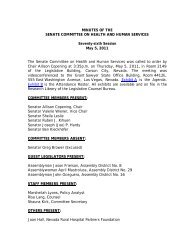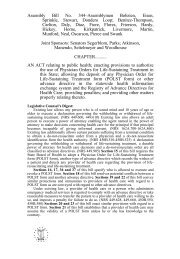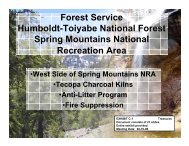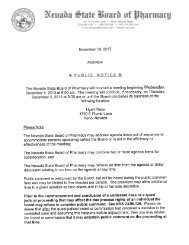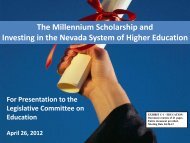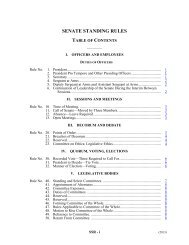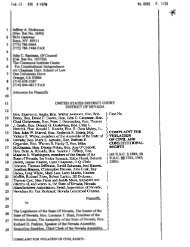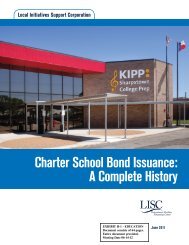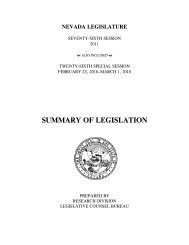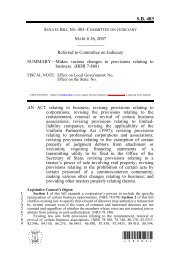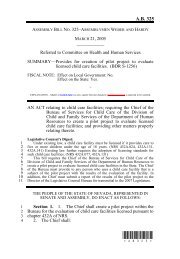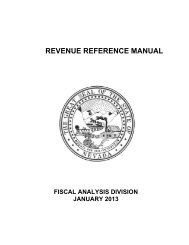Nevada Pre-Kindergarten Standards
Nevada Pre-Kindergarten Standards
Nevada Pre-Kindergarten Standards
Create successful ePaper yourself
Turn your PDF publications into a flip-book with our unique Google optimized e-Paper software.
Brewer, JoAnn. Introduction to Early Childhood Education. 2nd Edition. Allyn and Bacon. Boston. 1995.<br />
Clements, D.H. and M. Battista. Constructivist Learning and Teaching. Arithmetic Teacher. September 1990. pp 34¬35.<br />
Ginsburg, H.P. Children’s Arithmetic: How They Learn It and How You Teach It. (2nd edition). Austin, TX: Pro Ed. 1989.<br />
Kamii, C. Children Reinvent Arithmetic. Teachers College <strong>Pre</strong>ss. New York. 1985.<br />
Mokros, J. Beyond Facts and Flash Cards: Exploring Math With Your Kids. Heinemann. Portsmouth, NH. 1996.<br />
Saracho, Olivia. Right From the Start. Allyn and Bacon. Boston. 1994.<br />
Smith, Susan Sperry. Early Childhood Mathematics. Allyn and Bacon. Boston 1997.<br />
Stenmark, J.K., V. Thompson, and G. Coates. Family Math for Young Children. University of California. 1997.<br />
Williams, C. and C. Kamii. “How Do Children Learn by Handling Objects?” Young Children. November 1986. pp 23¬26.<br />
Carpenter, T.P., and Moser, J.M. (1983). The acquisition of addition and subtraction concepts. In The acquisition of mathematical concepts and processes, eds. R. Lesh<br />
and M. Landau, 7–44. New York: Academic <strong>Pre</strong>ss.<br />
Carpenter, T.P, and Moser, J.M. (1984). The acquisition of addition and subtraction concepts in grades one through three. Journal for Research in Mathematics Education,<br />
15: 179–202.<br />
Carpenter, T.P., Ansell, E., Franke, M.C., Fennema, E., and Weisbeck, L. (1993). Models of problem solving: A study of kindergarten children’s problem-solving processes.<br />
Journal for Research in Mathematics Education, 24(5): 427–440.<br />
Carpenter, T.P., Carey, D., and Kouba, U. (1990). A problem solving approach to the operations. In Mathematics for the young child, ed. J.N. Payne, 111–131. Reston, VA:<br />
National Council of Teachers of Mathematics.<br />
Ginsberg, H.P. (1996). Toby’s math. In The nature of mathematical thinking, eds. R.J. Sternberg and T. Ben-Zeev, 175–202. Hillsdale, NJ: Lawrence Erlbaum Associates.<br />
McCully, E.A. (1992). Mirette on the high wire. New York: G.P. Putnam & Sons.<br />
National Council of Teachers of Mathematics. (1989). Curriculum and evaluation standards for school mathematics. Reston, VA: Author.<br />
Peterson, P., Fennema, E., and Carpenter, T. (1989). Using knowledge of how students think about mathematics. Educational Leadership, 46(4): 42–46.<br />
Resnick, L., Bill, V., Lesgold, S., and Leer, N. (1991). Thinking in arithmetic class. In Teaching advanced skills to at-risk students, eds. B. Means, C. Chelmer, and M.<br />
Knapp. San Francisco: Jossey-Bass.<br />
Schwartz, L.L. (1994). Calendar reading: A tradition that begs remodeling. Teaching Children Mathematics, 1: 104–109.<br />
Singer, M. (1993). Puppy says 1,2,3. Hong Kong: Reader’s Digest Young Families, Inc.<br />
Smith, S.S. (1997). Early childhood mathematics. Needham Heights, MA: Allyn & Bacon.<br />
Vygotsky, L.S. (1978). Mind in society: The development of higher psychological processes. Cambridge, MA: Harvard University <strong>Pre</strong>ss.<br />
95



